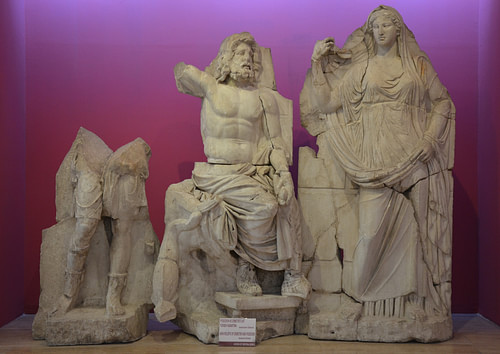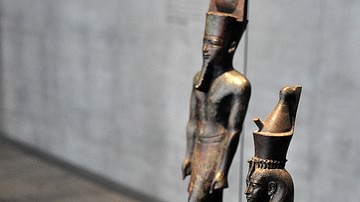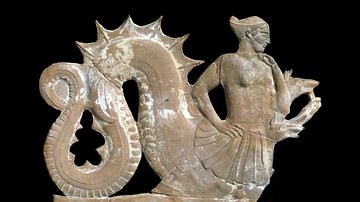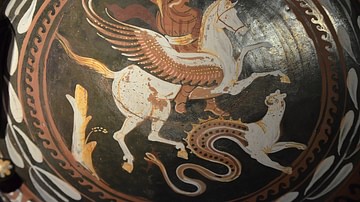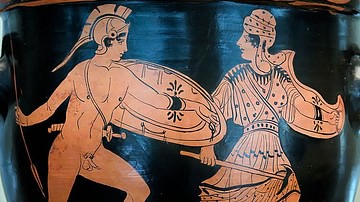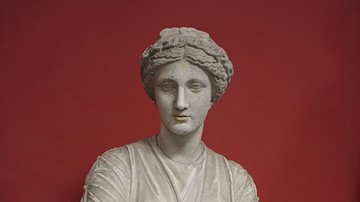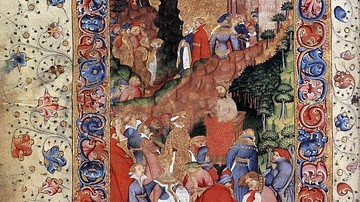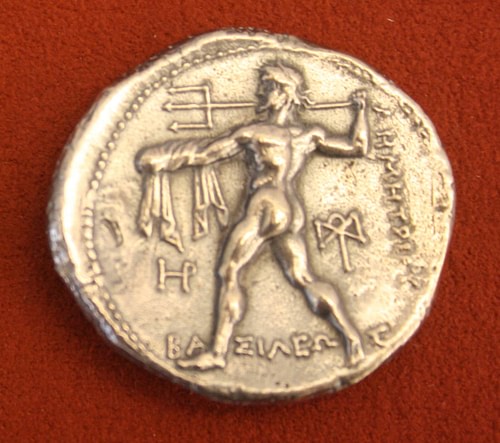
Poseidon was the Greek god of the sea and rivers, creator of storms and floods, and the bringer of earthquakes and destruction. He was perhaps the most disruptive of all the ancient gods but he was not always a negative force. He was a protector to mariners and, as a tamer of horses, the patron of that animal and horse breeding. To the Romans, he was known as Neptune.
Origins & Family
Cults to Poseidon date as far back as the late Bronze Age and the Mycenaean civilization (at its peak from the 15th to 12th century BCE), as attested by Linear B inscriptions found at Pylos in the Peloponnese and Knossos on Crete. Indeed, the god seems to have been one of the most important Mycenaean deities, perhaps no surprise given the culture's obvious seafaring skills. It may be that Poseidon was a mix of an indigenous but pre-Greek god with Potis, an Indo-European deity. Pylos, we know, had Poseidon as its main god with a priestess as the head of his cult.
In later Greek mythology, Poseidon was the son of Kronos and Rhea, and brother of Zeus and Hades. He was a key figure in the battles for control of the universe between the Titans, the Giants, and the Olympians. On their victory, the three brothers drew lots to decide which domain they would reign over, and Poseidon gained the seas. The god dwelled in magnificent golden mansions beneath the sea, beautifully adorned with coral and sea flowers. Traditionally, this undersea palace, which included the god's stables of fine white horses, was located near Aegae in Euboea. Seemingly not content with the seas alone, Poseidon often interfered in the plans of Zeus, and once even attempted to overthrow his brother with the aid of Hera and Athena. It was as punishment for this treachery that Poseidon was made to build the magnificent walls of Troy.
Poseidon's wife was the Nereid Amphitrite although she had proved a little difficult during the courting process and once fled to the Atlas mountains. Fortunately, the sea god was helped by the dolphin Delphinus who persuaded Amphitrite to return and marry Poseidon. In gratitude, Poseidon ensured that Delphinus was remembered for all time by making a constellation in her likeness which still carries her name.
The god's most famous son with Amphitrite was Triton, who was half-man, half-fish. Two other children were Rhode and Benthesicyme. However, as with the other divinities, Poseidon fathered many other offspring with various partners. Most notable are Theseus (with Aithra), Polyphemus the Cyclops (whom Odysseus famously encountered on his lengthy return from the Trojan War), Orion the hunter (with the daughter of Minos), the flying horse Pegasus (after the rape of Medusa), the wild horse Arion, and Charybdis (with Gaia), the ship-eating sea monster which created terrible whirlpools. Perhaps justifiably jealous of all these affairs, Poseidon's infatuation with Scylla, the daughter of the sea god Phorcys, led Amphitrite to cast some magic herbs in the girl's bath which turned her into a raging monster with twelve feet and six heads. Both Scylla and Charybdis would menace mariners who passed the Straits of Messina between Sicily and mainland Italy.
Poseidon was himself responsible for another terrible creature - the Minotaur. Minos' failure to sacrifice the bull given as a gift by the god resulted in Poseidon bewitching Minos' wife Pasiphae into falling in love with the bull; and the fruit of their amorous relationship was the half-man, half-bull creature which inhabited the labyrinth of Knossos.
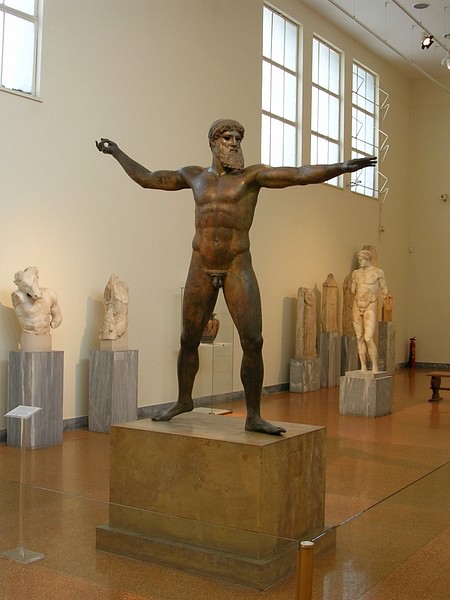
In Hesiod & Homer
The god is a major protagonist in the Trojan War of Homer's Iliad, where he supports the Greeks and gives them either encouragement with rousing speeches, often in disguise as various Achaean personalities, or actually leads them in battle with flashing sword. However, he does also give aid to the Trojan hero Aeneas in order to escape from the fearsome Achilles. Poseidon also features in Homer's Odyssey as the nemesis of Odysseus. In revenge for the blinding of his son Polyphemus, he cursed Odysseus to wander the sea for ten years. Poseidon is most often described by both Homer and Hesiod as 'deep sounding Earth-shaker', the 'dark-haired one' and 'encircler of the earth.' The latter title reminds that many ancients believed that all waterways were connected and that the land floated on water. For this reason, it made sense that one god looked after all these waterways which encircled the earth (even if many rivers and springs had their own specific personifications in mythology).
Worship & Sacred Sites
In the Greek religion, Poseidon was said to hold the Isthmus of Corinth in special regard; probably as it was an important sea route. The god was particularly revered here and was the focus of horse races and other events at the Panhellenic Isthmian games which were held in his honour near Corinth. The games were held every two years in the spring and, like the Olympic Games, athletes, charioteers, and horse racers competed for prizes, in this case, a prestigious crown of first pine and then, in the Classical period, of dry celery. Corinth was also one of the earliest cities to connect Poseidon to maritime trade and navigation as indicated by votive clay plaques dating to the Archaic period. Sounion was another strategic site close to the god, and his 5th-century BCE temple still stands on the promontory which overlooks ships entering the Saronic gulf. The god was honoured by boat races held at the cape once every four years.
In the legendary competition with Athena to win the patronage of Athens, Poseidon offered to the city the gifts of a saltwater spring and a horse. However, Athena's gift of an olive tree gained greater favour, and it was she who would become the patron of the great city. Still, the god was honoured by the annual Posideai festival - which perhaps had more to do with agriculture than the sea - and the mid-winter month of Posideon carried his name.

As a protector during earthquakes (despite the fact he was also seen as their cause), the god was often appealed to as Poseidon Asphaleios, and a temple to the god was built on Rhodes for just that purpose. Poseidon had an oracle at Taenarum in Laconia and important sanctuaries at the small island of Calauria off Troezen and Onchestus in Boeatia. Onchestus had a curious ceremony whereby horses pulled a riderless chariot through the site, and if it crashed, then the chariot was dedicated to the god. Many coastal settlements across the Mediterranean bore his name (for example, Posidonia/Paestum), and mariners and fishermen everywhere made votive offerings to Poseidon for protection. His cult worshippers most frequently sacrificed bulls, stallions, and male sheep. Finally, the god was also credited as being the father of at least 30 different semi-historical city-founders and several major tribes across Greece, likely reflecting the importance the god had in the Mycenaean period.
Representation in Art
Poseidon is most commonly depicted in ancient Greek art as mature and bearded. He often brandishes his trident, fashioned by the Cyclopes, with which he would create earthquakes by striking it to the ground. He is also frequently portrayed riding his golden chariot pulled by hippocamps - half-horse and half-serpent creatures with fishtails - or gold-shod horses, of which he was patron. Dolphins, seahorses, and tuna fish are additional marine animals frequently seen in the god's company in art.
The god appears with Athena in their competition to become the patron of Athens on the west pediment of the Parthenon (447-432 BCE). Poseidon appeared on coinage, perhaps most strikingly the silver tetradrachms of ancient Macedon (306-283 BCE) where he seems about to hurl his trident. Perhaps the most celebrated representation of Poseidon is the 2 metre-high bronze statue (c. 460 BCE) from Cape Artemisium (although such is the similarity in the depiction of Poseidon and Zeus in ancient Greek art, it may well represent the latter). The statue was recovered from a shipwreck in the 1920s CE, and the magnificent striding figure now dominates one of the rooms of the National Archaeological Museum of Athens.
